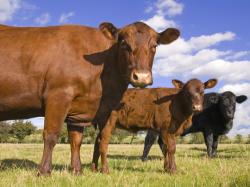Certified Angus Beef's On Target – Perspectives
April 6, 2016 | 3 min to read

This year I’ve had the opportunity to visit with folks from both ends of the beef supply chain: seedstock and commercial ranchers and foodservice specialists from across the nation. While both are in the beef business, the differing perspectives these groups bring to a beef and cattle conversation is interesting to say the least.
Our growing beef herd brings the sharpest contrast in opinion. Ranchers are excited to have enough feed and forage to support an expanding cowherd, but they worry the increase in beef supplies will mean lower prices at the ranch gate. Record profitability and favorable weather in many areas since 2014 resulted in a quick million-head expansion in that beef herd. Logic says that many more calves will challenge prices.
The larger supply and expected lower beef prices comes as good news to foodservice specialists, who are once again excited to feature beef on the menu at more affordable prices. Restaurants and related businesses did amazingly well last year, considering beef was 57% higher than pork and 207% higher priced than chicken.
End-users who feature a USDA Select product will tend to lose beef business because of more favorable prices for pork and chicken, and less opportunity for quality differentiation. Demand continues to grow for high-quality beef because of the focus on taste, rather than trying to win a price battle with less expensive proteins that need a sauce for acceptable flavor.
Rancher and foodservice perspectives may differ, but both are ultimately selling a beef product. Both determine gross value as price times weight, yet ranchers detest lower prices and foodservice specialists have been anticipating lower prices since the start of the rebuilding phase. The difference lies in ability to increase sales.
At a lower price point for beef, the foodservice specialist can begin to compete with other center-of-the-plate protein options while providing end-users with a high-quality eating experience. Lower prices allow greater sales volume to existing customers and another reason to visit new prospects with a more affordable quality product.
When you talk with ranchers, they often suggest those end-users have an advantage because they can increase volume at a lower price, just passing along their costs, plus margin, to the diner – a luxury not afforded to the rancher selling calves at auction. Yet the foodservice specialist considers the ranch options of controlling input costs, adjusting quality and quantity of calves and the resulting carcass as primary opportunities to set their own course.
As winter turns to spring, the time for winter feed cost cutting comes to a close and the opportunity to add value to the next crop of calves is upon us. Ranchers have historically used cost reduction as a way to improve profitability when prices trend lower, since it’s not easy to increase production and quality in the short term.
Ranchers are limited to increasing “volume” or number of calves produced by the ranch environment. Continued selection for greater weaning, yearling and carcass weight may offer the chance to increase production over the long term, thus growing ranch volume. But even though more weight drives profit, an increasing beef supply puts more pressure on quality to sustain demand.
Herd management must look beyond cost cutting and simply adding cheap pounds at the lower end of Choice or Select. As the nation’s average quality grade continues to improve, the challenge to produce better-than-average cattle grows.
From a mathematical perspective, half of every population is below average. If you ask a group of ranchers how many raise below-average cattle, rarely do you get an even split in the audience. As the grass turns green, take every opportunity to add value to your end product, beef, and offer your buyers above-average cattle.
Source: Certified Angus Beef LLC
